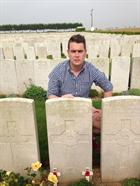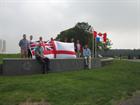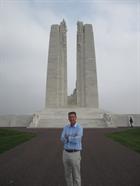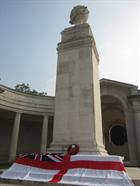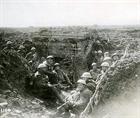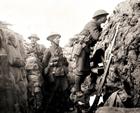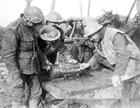Family connections remembered on WW1 battlefield tour
Two members of 824 Naval Air Squadron followed in the footsteps of their great ancestors as they took advantage of a special tour of battlefields in Northern France.
The pilgrimage led by Lieutenant Commander Mark Tetley left Royal Naval Air Station Culdrose and crossed the channel, just as other young men had done so 100 years earlier. Passing through Calais the Naval group headed for Etaples, to see the huge military cemetery that now lies where once the training grounds and field hospitals stood.
The remains of 10,771 Commonwealth soldiers are laid out in perfect rows of white Portland stone, many with dates recorded in 1919, testifying to the suffering endured by the seriously wounded too ill to return to Britain, who died in tented hospitals months after the armistice in November 1918. For many in the group this was their first time to the battlefields and seeing thousands of names inscribed on walls and headstones, brought home the enormity of the sacrifice made in the tragic years between 1914and 1918.
Setting up their base in Amiens they tour battlefields and cemeteries that contain the numerous fatalities from British, Canadian, Australian, South African and German armies, across the surrounding areas of Arras and the Somme. Paying respects to their Cornish connections of their base at Culdrose, they visited the huge crater sites where Cornish miners had stealthily dug beneath German lines. Laying explosives under enemy trenches the effect when detonated was devastating, throwing earth and German soldiers hundreds of feet into the air.
This trip had a very personal meaning to me,” said Leading Air Engineer Technician Nathan Astill, who visited the sites where his Great, Great Uncles, brothers Albert and Ernest Clements fought and died during the First World War. “It's a very humbling and moving experience to visit my ancestor’s final resting places and I was really grateful for the chance to see for myself what it was like.”
Ernest was 24 when he died in August 1916 during fighting on the Somme, unfortunately his body was never recovered hence his name being remembered on the Thiepval memorial. The memorial records the names of 72,000 British and Commonwealth soldiers who have no known grave. His younger brother Albert was only 23 when he was injured a year later in April 1917 supporting forward trenches. Suffering a gunshot to his stomach he was evacuated swiftly back to a field hospital in the rear areas but unfortunately died the same day. Albert is buried at Duisans British Cemetery 30 miles to the North of Thiepval.
Another group member, Lt Cdr Alastair Castle was also able to follow his Great Grandfather’s journey as he served on the Somme. Captain William Ivor Castle was the Canadian Official War Photographer between August 1916 and June 1917 taking over 800 pictures at the battles of Courcelette and Vimy Ridge, including some of the first pictures of tanks in battle. William was gassed as he took pictures of exploding shells on the Somme in 1916, but survived to return to Londonand launched two major exhibitions of official war photographs attended by royalty and the public to boost morale, for which he was awarded the MBE.
“Through William’s pictures you begin to understand what he and many others witnessed throughout the Great War. The Memorials and cemeteries that cover this landscape today really bring home the enormity of the fighting and the struggle he and others endured,” said Lt Cdr Alastair Castle.
The final stop in the area was the Arras Flying Services Memorial where sailors and airmen of the fledgling Royal Naval Flying Service, who lost theirs lives, are remembered the Naval Party laid a wreath in tribute to the young men who paved the way for what became the Fleet Air Arm in later years.

